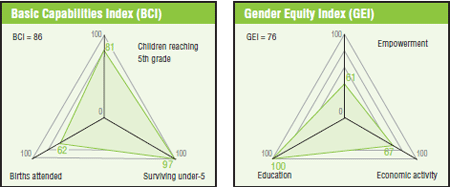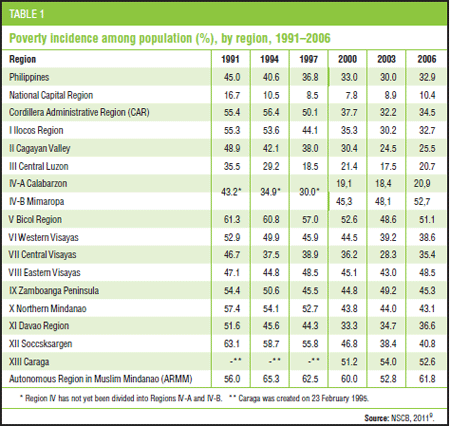Clearing the path to sustainability
Philippine Rural Reconstruction Movement (PRRM)
Social Watch Philippines
Isagani R. Serrano
Addressing the vulnerability of the country’s already degraded environment is as important as making the economy grow. In addition, the Philippines long ago exceeded the 0.4 hectares per person required to satisfy the optimum food requirement/capacity. Decentralization efforts attempting to create growth centres away from Manila are still unable to break the elite and urban-centred structure of power and resources. The Government must strive to find ways – in cooperation with farmers, NGOs, the mass media, schools and the national agriculture research system – to achieve long-term food security and environmental sustainability.
 |
In 2010, inspired by the Philippines’ second greenhouse gas (GHG) inventory, then president Gloria Macapagal-Arroyo pompously announced that the country was now a net carbon sink. Carbon intensity, as expressed by CO2 emissions, may indicate something about the level and nature of development, but there is much more to consider. Indicators vary widely, depending on what people value most.
Low CO2 emissions are a poor indicator of sustainable development. A more sensitive single indicator of a society’s well-being is probably the infant mortality rate, which reveals the quality of nutrition and healthcare. In addition, it is connected to other basic indicators such as the quality of water resources, housing and education, and especially women’s education level. It can also be an indicator of State failure. In the case of the Philippines, child mortality indicators are discouraging: the infant mortality rate (under 1) stood at 26 per 1,000 in 2009 and the under-5 mortality rate at 33 per 1,000. While these figures do show some improvement when compared to data from 1990 (41 and 34 respectively), the country’s problems, as seen below, remain structural.
Poverty and inequality: the same old story
Despite the restoration of democracy in 1986 and the subsequent succession of regimes that promised to eradicate poverty and reduce inequality, and despite the fact that the economy has been growing, the country is still stuck with high poverty/high inequality alongside continuing environmental degradation.
While poverty declined to 32.9% in 2006 from 42% in 1991, the faces of those in poverty remained the same: rural, landless, indigenous/tribal, Muslim and female. Inequality has hardly decreased during the same period: it was 0.4680 in 1991 and 0.4580 in 2006. This is a high level compared to the majority of the Philippines’ Asian neighbours and means the country is only slightly better-off than most countries in Latin America (the most unequal region on the planet). Most importantly, there is wide inequality among the country’s regions, provinces and municipalities.
 |
The gap between the richest 20% and the poorest is widening in spite of measures such as land reform and local autonomy. The regions with the most inequitable income distribution are Central Visayas, Eastern Visayas, Zamboanga Peninsula, Northern Mindanao and Caraga. These regions have Gini coefficients higher than 0.44. More than 50% of the 20 poorest provinces were in Mindanao in 2003 and 2006, with Tawi-Tawi having the highest poverty incidence in 2006.
Debt and corruption – developmental nightmares
The Government derives two thirds of its revenue mainly from taxes on fixed-income earners. Over the years it has consistently spent more than it earns. It sets huge annual budgets and makes up for deficits by borrowing. It wants to cap the 2011 budget deficit at 3.2% of gross domestic product (GDP) or some PHP 290 billion (USD 6.69 billion).
Mounting debts and debt service are the bane of Philippine development. The country’s outstanding debt ballooned from PHP 701 billion in 1990 to PHP 4.4 trillion in 2009 (USD 16.2 million to USD 101.5 billion), showing a steady increase except for a slight decline in 2006 and 2007. This is more than 50% of the country’s GDP. The debt-to-GDP ratio remained high at 57.7% at the end of 2009 although it had declined from 63.8% in 2006. In September 2010 each of the 92.2 million Filipinos could be said to owe PHP 47,039 (USD 1,091) to local and foreign creditors.
About a third of the national budget goes to paying the interest and principal of the country’s mounting debt stock. That is a third of the pie sliced off from poverty reduction activities. In addition, corruption has been a constant feature and has triggered most of the regime changes since the days of President Marcos. In 2004 Macapagal-Arroyo said that corruption was strangling the Philippines and called on citizens to “join hands to root out this evil.” The evil, however, continues to be very much alive and to hinder Philippine development.
The need to break the urban-centred structure
The country’s economic geography demonstrates highly uneven development and unequal distribution of created wealth. Primate cities suck up most of the resources. It is no wonder, therefore, that small savings deposited in faraway rural banks end up eventually in big banks in Makati and are then lent to big borrowers who prefer to invest in already highly developed areas.
The conflict in Mindanao is instructive of the country’s development situation. Violence first flared in the 1960s when the Muslim minority – known as the Moros – launched an armed struggle for their ancestral homeland in the south. Fighting escalated in 2008 after a decade-long peace process, but a truce was signed in July 2009. What needs to be underscored is that much of the violence is fuelled by deep poverty rooted in decades of under-investment. Mindanao, an extremely rich area hardly visited by typhoons, could achieve prosperity if left to itself, but it has failed to make progress on something as basic as the Millennium Development Goals (MDGs). The poverty and inequality that continue to dog that region, especially the Moro and lumad (indigenous) areas, are rooted in historical injustices and discrimination dating back to the colonial past and perpetuated by a succession of post-colonial regimes. They are embedded in unjust economic, political and socio-cultural structures urgently needing change.
The structure of growth and wealth creation in the Philippines contradicts the mantra of broad-based, inclusive growth. Attempts to create growth centres away from Manila will never work unless the Government alters the current elite and urban-centred structure of power and resources. The 1991 Local Government Code, although a landmark piece of legislation, has yet to result in the decentralization of elite power. Resources and authority need to be deliberately transferred from the richer regions to the poorer ones.
Population growth and vulnerability
Carrying capacity is a real problem in a mountainous archipelago with a population that has grown from 62 million in 1990 to about 95 million in 2010 and is expected to reach over 100 million by 2015. Although the population growth rate decreased from a high of 2.36% a year in 2000 to 2.04% in the 2007 census, it is still considered to be one of the highest in Asia. This high population growth rate makes the country vulnerable. For each person, a total of 0.004 hectares would be needed to satisfy optimum food requirements/capacities, and this possibility has long since been exceeded. The population issue is also a reflection of poverty and inequality. Those with more money and more secure futures tend to have fewer children; the poor have bigger families and rely on numbers as productive assets and as their old-fashioned social security fallback for old age.
Although farmlands are shrinking, sustainable agriculture might be able to feed these millions. But for this to happen, the Government must work in cooperation with farmers, NGOs, the mass media, schools and the national agriculture research system to find ways of achieving long-term food security and environmental sustainability.
Conclusion
Addressing the vulnerability of the Philippines’ already degraded environment is as important as growing the economy. Regarding development and environment as a trade-off is a false dilemma. Human needs cannot be met from an impoverished environment, and impoverished human beings do not care about protecting the environment.
Restoring the country’s forest cover, now down to 27%, back to the ideal 40% for an archipelagic system like the Philippines is critical. Mining and other extractive industries will have to be put on hold or under the strictest control. The scope provided by coastal and marine zones, if restored from their present degraded state, could help the nation through worst-case scenarios that would affect food security and human settlements.
Keeping debt at sustainable levels and controlling the repayment haemorrhage are central to solving the issue of where money for development will come from. The Government borrows a lot to fund its MDG commitments. Its major anti-poverty programmes, such as conditional cash transfer, run on borrowed money and further strain the country’s fiscal situation. Corruption is also symptomatic of the state of governance, and curbing it is therefore a big part of the solution to the Philippines’ development problem.
From 1972 to 2010 the Philippines has gone from democracy to dictatorship and back again. People’s participation has been a key factor. Such participation has taken different forms, mostly peaceful movements addressing a range of issues including regime change. Yet it seems that after all those changes things remain the same. The country has yet to see real empowerment of the masses matching that of the elite. When that time comes, there will be a better guarantee of governance for sustainable development.


